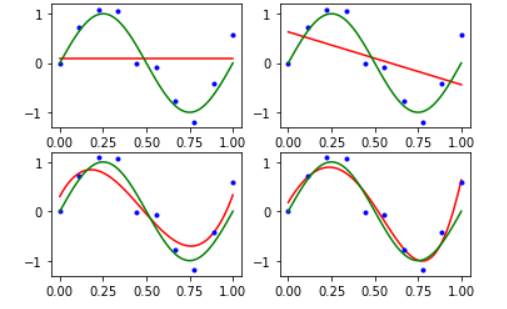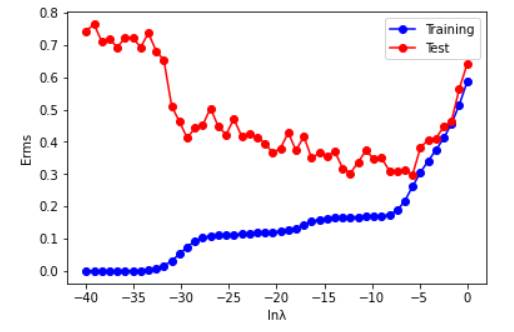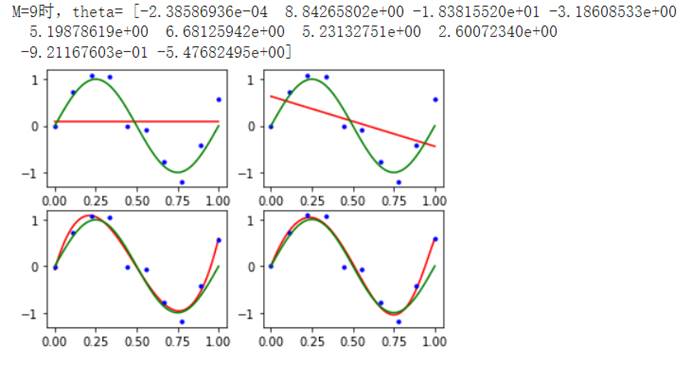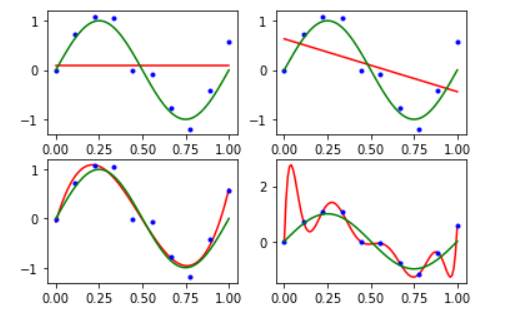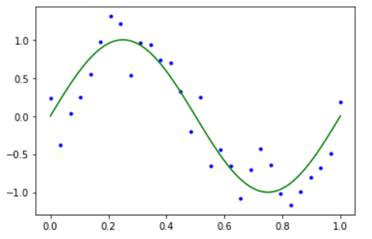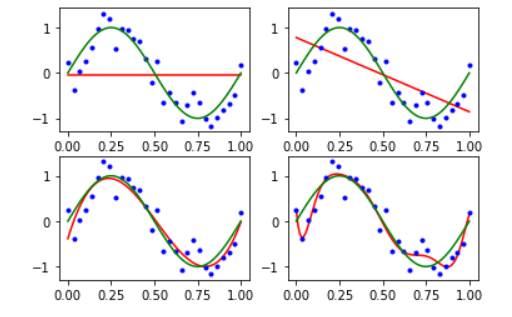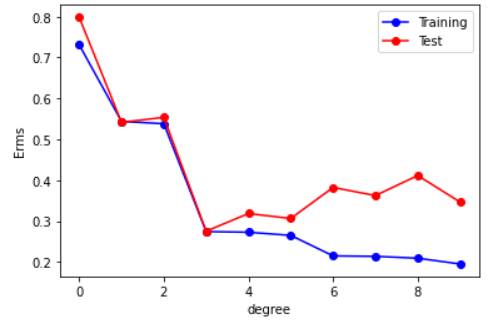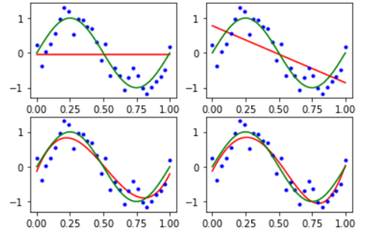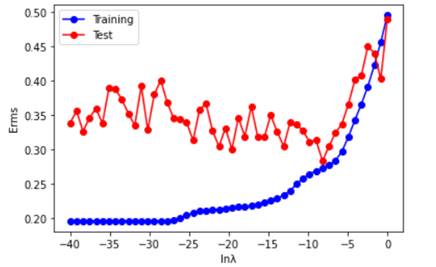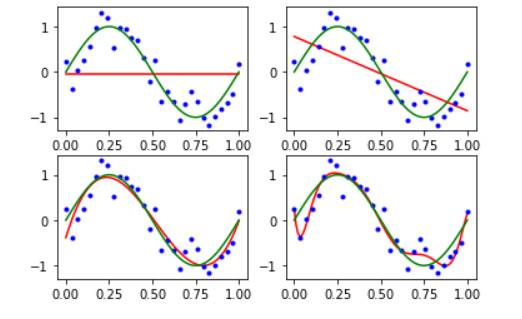1
2
3
4
5
6
7
8
9
10
11
12
13
14
15
16
17
18
19
20
21
22
23
24
25
26
27
28
29
30
31
32
33
34
35
36
37
38
39
40
41
42
43
44
45
46
47
48
49
50
51
52
53
54
55
56
57
58
59
60
61
62
63
64
65
66
67
68
69
70
71
72
73
74
75
76
77
78
79
80
81
82
83
84
85
86
87
88
89
90
91
92
93
94
95
96
97
98
99
100
101
102
103
104
105
106
107
108
109
110
111
112
113
114
115
116
117
118
119
120
121
122
123
124
125
126
127
128
129
130
131
132
133
134
135
136
137
138
139
140
141
142
143
144
145
146
147
148
149
150
151
152
153
154
155
156
157
158
159
160
161
162
163
164
165
166
167
168
169
170
171
172
173
174
175
176
177
178
179
180
181
182
183
184
185
186
187
188
189
190
191
192
193
194
195
196
197
198
199
200
201
202
203
204
205
206
207
208
209
210
211
212
213
214
215
216
217
218
| import numpy as np
import matplotlib.pyplot as plt
%matplotlib inline
def generate_data_1(size):
x = np.random.rand(size)
y = np.sin(2 * np.pi * x) + np.random.normal(0,0.3,size)
return x, y
def generate_data_2(size):
x = np.linspace(0,1,size)
y = np.sin(2 * np.pi * x) + np.random.normal(0,0.3,size)
return x, y
size = 30
x_train, y_train = generate_data_2(size)
x_func = np.linspace(0,1,100)
y_func = np.sin(2 * np.pi * x_func)
plt.plot(x_train,y_train,'.b')
plt.plot(x_func,y_func,'-g')
plt.show()
def polynomial_X(x, exp):
if(exp == 0):
return np.ones(x.size)
X = np.vstack((np.ones(x.size),x))
for i in range(2, exp+1):
X = np.vstack((X, np.power(x, i)))
return X.T
def train_analytic(x_train, exp):
X = polynomial_X(x_train, exp)
if(exp == 0):
theta = 1/(X.T.dot(X)) * X.T.dot(y_train)
else:
theta = np.linalg.pinv(X.T.dot(X)).dot(X.T).dot(y_train)
return theta
def predict_analytic(x_train, x_test, exp):
theta = train_analytic(x_train, exp)
return polynomial_X(x_test, exp).dot(theta)
j = 1
for i in [0, 1, 3, 9]:
y_predict = predict_analytic(x_train, x_func, i)
plt.subplot(2,2,j)
j += 1
plt.plot(x_func, y_predict, '-r')
plt.plot(x_train,y_train,'.b')
plt.plot(x_func,y_func,'-g')
plt.show()
def calculate_erms(y, t):
return np.sqrt(np.mean(np.square(y-t)))
x = np.array([0,1,2,3,4,5,6,7,8,9])
training_erms = np.zeros(10)
test_erms = np.zeros(10)
theta = []
for i in range(10):
theta.append(train_analytic(x_train, i))
y_train_predict = polynomial_X(x_train, i).dot(theta[i])
training_erms[i] = calculate_erms(y_train_predict, y_train)
y_test_predict = predict_analytic(x_train, x_func, i)
test_erms[i] = calculate_erms(y_test_predict,
y_func+np.random.normal(0,0.3,len(y_func)))
plt.plot(x, training_erms, 'o-b', label="Training")
plt.plot(x, test_erms, 'o-r', label="Test")
plt.legend()
plt.xlabel("degree")
plt.ylabel("Erms")
plt.show()
def train_analytic_with_regularization(x_train, exp, lamb):
X = polynomial_X(x_train, exp)
if(exp == 0):
theta = 1/(X.T.dot(X)+lamb) * X.T.dot(y_train)
else:
theta = np.linalg.pinv(X.T.dot(X)+lamb*np.eye(X.shape[1])).dot(X.T).dot(y_train)
return theta
def predict_analytic_with_regularization(x_train, x_test, exp, lamb):
theta = train_analytic_with_regularization(x_train, exp, lamb)
return polynomial_X(x_test, exp).dot(theta)
j = 1
lamb = 0.001
for i in [0, 1, 3, 9]:
y_predict = predict_analytic_with_regularization(x_train,x_func,i,lamb)
plt.subplot(2,2,j)
j += 1
plt.plot(x_func,y_predict, '-r')
plt.plot(x_train,y_train,'.b')
plt.plot(x_func,y_func,'-g')
plt.show()
x = np.linspace(-40, 0)
training_erms = np.zeros_like(x)
test_erms = np.zeros_like(x)
X = polynomial_X(x_train, 9)
theta = []
for i,index in zip(x, range(x.size)):
theta.append(train_analytic_with_regularization(x_train, 9, np.exp(i)))
y_train_predict = X.dot(theta[index])
training_erms[index] = calculate_erms(y_train_predict, y_train)
y_test_predict = predict_analytic_with_regularization(x_train, x_func, 9, np.exp(i))
test_erms[index] = calculate_erms(y_test_predict,
y_func+np.random.normal(0,0.3,len(y_func)))
plt.plot(x, training_erms, 'o-b', label="Training")
plt.plot(x, test_erms, 'o-r', label="Test")
plt.legend()
plt.xlabel("lnλ")
plt.ylabel("Erms")
plt.show()
def gradient_descent(X, y, alpha, iterations):
if(np.size(X.shape) == 1):
theta = 0
else:
theta = np.zeros(np.size(X, 1))
for i in range(iterations):
theta = theta - alpha * X.T.dot(X.dot(theta) - y)
return theta
def gradient_descent_predict(X, y_train, X_test, exp, alpha, iterations):
theta = gradient_descent(X, y_train, alpha, iterations)
if(exp == 9):
print("M=9时,theta=", theta)
return X_test.dot(theta)
j = 1
iterations = 1000000
for i in [0, 1, 3, 9]:
plt.subplot(2,2,j)
j += 1
X = polynomial_X(x_train, i)
X_test = polynomial_X(x_func, i)
y_predict = gradient_descent_predict(X, y_train, X_test, i, 0.01, iterations)
plt.plot(x_func,y_predict,'-r')
plt.plot(x_train,y_train,'.b')
plt.plot(x_func,y_func,'-g')
plt.show()
def conjugate_gradient(X, y):
esp = 1e-10
A = X.T.dot(X)
b = X.T.dot(y)
if (np.size(X.shape) == 1):
theta = 0
r = b - A*theta
p = r
r2 = r*r
alpha = r2 / (p * A * p)
theta = theta + alpha * p
else:
theta = np.zeros(np.size(X, 1))
r = b - A.dot(theta)
p = r
r2 = r.T.dot(r)
err = 1
while err > esp:
alpha = r2 / (p.T.dot(A).dot(p))
theta = theta + alpha * p
r = r - alpha * A.dot(p)
r2_new = r.T.dot(r)
err = np.sqrt(r2_new)
beta = r2_new / r2
p = r + beta * p
r2 = r2_new
return theta
def conjugate_gradient_predict(X_train, y_train, X_test):
theta = conjugate_gradient(X_train, y_train)
return X_test.dot(theta)
j = 1
for i in [0, 1, 3, 9]:
plt.subplot(2,2,j)
j += 1
y_predict = conjugate_gradient_predict(polynomial_X(x_train, i),
y_train, polynomial_X(x_func, i))
plt.plot(x_func,y_predict,'-r')
plt.plot(x_train,y_train,'.b')
plt.plot(x_func,y_func,'-g')
plt.show()
|












